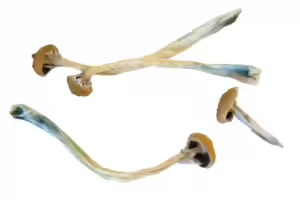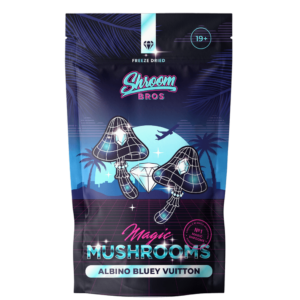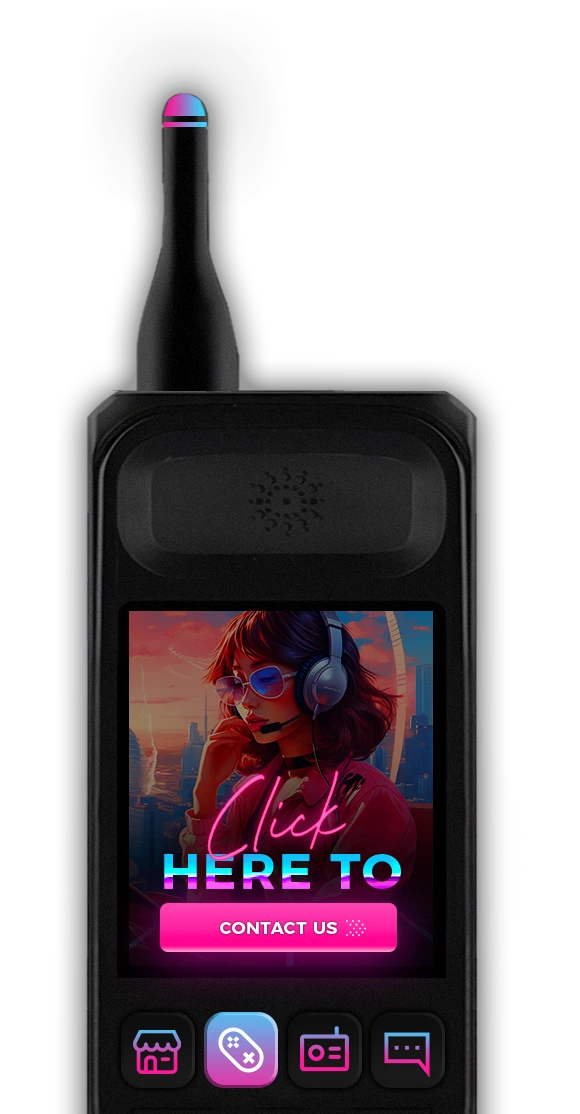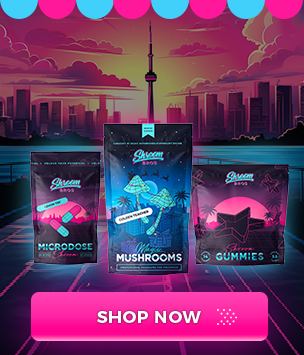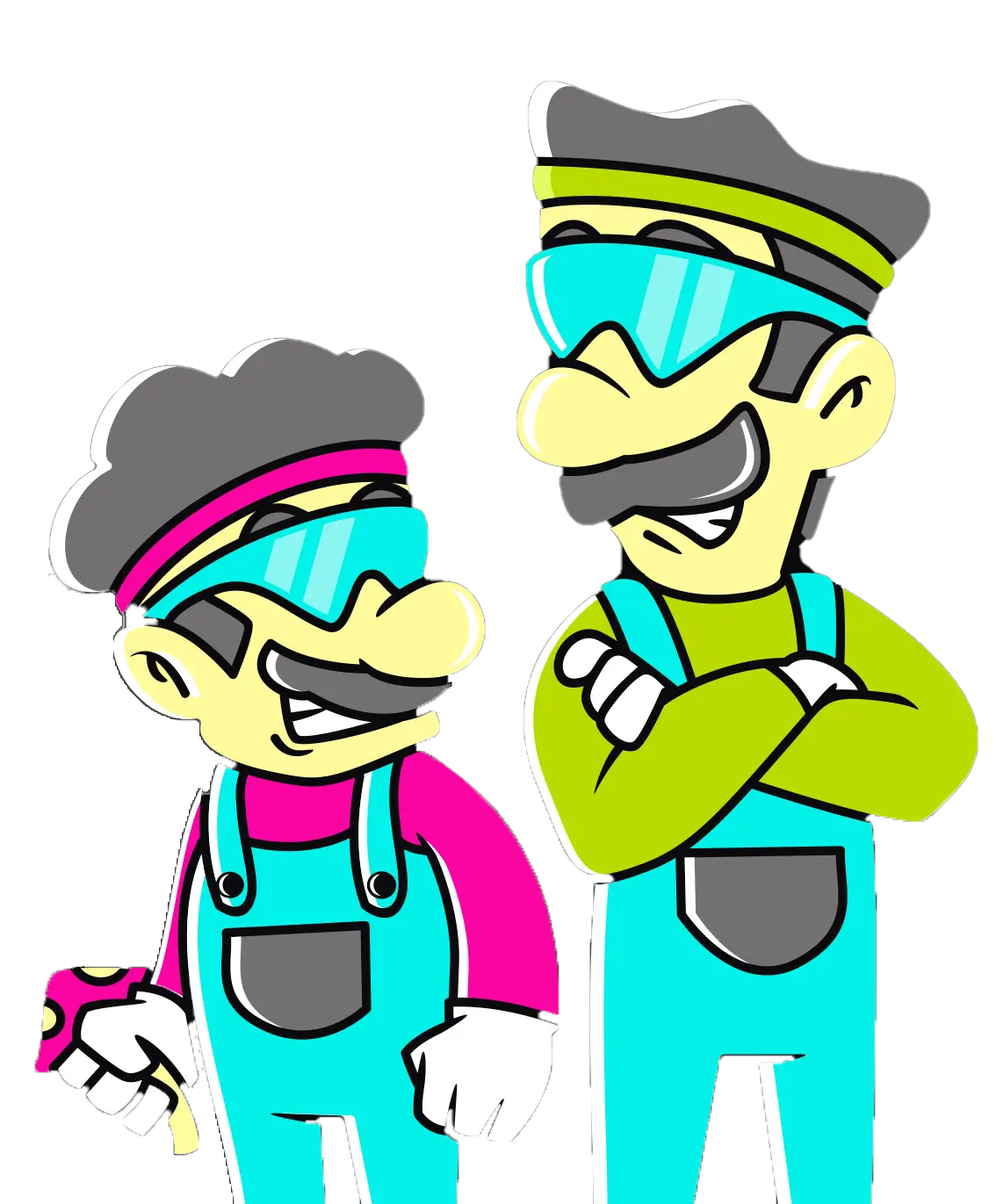To those who have ever foraged or handled magic mushrooms, the sight of a mushroom turning blue after being touched is both mesmerizing and mysterious. The transformation typically occurs in psychedelic mushrooms belonging to the genus Psilocybe, such as Psilocybe cubensis and Psilocybe cyanescens. When these mushrooms are bruised, cut, or damaged, the injured area quickly takes on a vivid blue color. This reaction is an almost immediate chemical response, leading many to wonder about its underlying cause.
2. The Chemistry of Psilocybin and Psilocin
To understand why these mushrooms turn blue, we need to start by looking at their psychoactive components: psilocybin and psilocin. Psilocybin is the primary active ingredient in magic mushrooms, responsible for their hallucinogenic effects. When ingested, psilocybin is converted into psilocin, which interacts with serotonin receptors in the brain to produce the psychedelic experience.
How Psilocybin and Psilocin Work
- Psilocybin is a prodrug, meaning it is biologically inactive until metabolized into psilocin.
- Psilocin is the actual compound that produces psychoactive effects by mimicking serotonin in the brain.
When a mushroom is damaged, enzymes interact with psilocybin and psilocin, triggering a cascade of reactions that lead to the blue pigmentation. This process, however, is more complex than a simple chemical change, involving several stages and molecules.
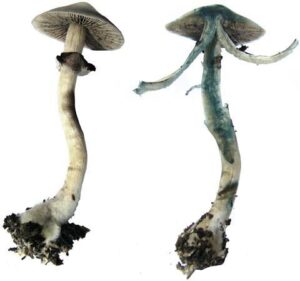
3. The Enzymatic Reaction Behind the Blue
The key to understanding the blue color in bruised mushrooms lies in the interaction between enzymes and the mushroom’s chemical compounds. When the tissue of the mushroom is damaged, a specific enzyme known as psilocybin oxidase (or more generally, polyphenol oxidase) is released. This enzyme initiates a series of reactions that result in the oxidation of psilocybin to psilocin, and then further into various quinones and other compounds.
Step-by-Step Breakdown of the Chemical Reaction
- Cell Damage: Physical damage to the mushroom cell walls releases the enzyme psilocybin oxidase.
- Oxidation of Psilocin: This enzyme oxidizes psilocin, converting it into different intermediates.
- Quinone Formation: The resulting compounds, called quinones, undergo a process called polymerization, where they bond together to form complex structures.
- Blue Pigment Production: These polymerized quinones give rise to the characteristic blue pigment seen in bruised mushrooms.
This reaction is quite similar to the browning process in apples or avocados, where polyphenol oxidase enzymes cause browning when the fruit is exposed to air.
4. Why Do Mushrooms Turn Blue? The Purpose in Nature
While the science explains how mushrooms turn blue, it still leaves us wondering why they evolved this way in the first place. From an evolutionary perspective, nature often doesn’t create traits without purpose. There are a few leading theories as to why magic mushrooms developed this unique trait:
A. Defense Mechanism
One widely held belief is that the blue coloration acts as a form of chemical defense. The blue hue could serve as a warning signal to animals, indicating that the mushroom contains potent psychoactive or toxic substances. This might deter herbivores or insects from consuming them, as the color suggests the presence of potentially harmful compounds.
B. Protection from Pathogens
Another theory suggests that the blue pigmentation may help protect the mushrooms from microbial attacks. The oxidation process involved in creating the blue color also generates reactive oxygen species, which are toxic to many bacteria and fungi. This could give the mushroom a survival advantage by reducing the risk of infection.
C. Random Biochemical Quirk
There is also the possibility that the blue color is merely a byproduct of chemical reactions without a specific evolutionary advantage. Some scientists argue that not all traits must have a direct survival benefit; instead, they can result from random variations that don’t necessarily affect the organism’s ability to thrive.
5. Significance of Blueing in Identifying Psilocybin Mushrooms
For foragers and psychonauts alike, the blueing reaction has become a reliable method for identifying psilocybin-containing mushrooms in the wild. Although not all magic mushrooms turn blue, and not all mushrooms that turn blue are psychoactive, this trait is a useful indicator.
Safety and Identification
Mushroom identification can be tricky, and relying solely on the blueing reaction is not recommended for definitive identification. There are many non-psychoactive mushrooms that can bruise blue or have similar colors, as well as deadly look-alikes like the Galerina species, which do not have hallucinogenic properties but can be lethal if ingested.
- Key Identification Points: Combining the blueing reaction with other characteristics, such as spore color, habitat, and cap shape, is crucial for accurate identification.
- Look-Alikes: Mushrooms like the poisonous Boletus species also turn blue when bruised, so caution is essential.
6. Cultural and Historical Perspectives on Blue Mushrooms
The color-changing properties of magic mushrooms have not only fascinated scientists but have also played a significant role in human culture. Throughout history, various cultures have incorporated these mushrooms into their religious, spiritual, and healing practices, often attributing the color change to mystical or divine powers.
Shamanic Traditions
In many indigenous cultures, the blueing of mushrooms was seen as a sign of their spiritual potency. Shamans and healers believed that the color change indicated a connection to the spirit world or that the mushrooms were imbued with special powers. This perception of the blueing reaction contributed to the reverence of these fungi in ancient rituals and ceremonies.
Modern Psychedelic Culture
In contemporary times, the blue color of magic mushrooms has become a symbol of their potency. Experienced psychonauts often use the intensity of the blueing reaction as an informal gauge of a mushroom’s psychoactive strength, although this method is not scientifically validated. The blueing effect has thus become a hallmark of the mystical and transformative journey that magic mushrooms offer.
7. Recent Scientific Research on Blueing Mechanisms
In recent years, scientific research has shed new light on the molecular intricacies of why magic mushrooms turn blue. A groundbreaking study published in 2019 by German chemists provided the first detailed explanation of the exact chemical pathways that lead to the blue color. They discovered that psilocin undergoes a dimerization reaction, forming oligomers that are responsible for the blue coloration.
The Discovery of Psilocylin and Psilocin Dimers
- Psilocylin: This novel compound, formed during the oxidation process, plays a significant role in producing the blue color.
- Dimerization Reaction: Psilocin molecules bind together to form dimers, which further polymerize into a series of compounds that manifest as the blue pigment.
This study highlighted that the bluing reaction is more than a simple oxidation but involves complex biochemical interactions that are still being fully understood. The discovery of these dimers marks a major advancement in our understanding of the chemistry behind this phenomenon.
8. Why Not All Magic Mushrooms Turn Blue
It’s worth noting that not all psilocybin-containing mushrooms exhibit this blueing reaction. Several factors influence whether a mushroom will turn blue, including its species, environmental conditions, age, and the concentration of active compounds.
Factors Influencing the Blueing Reaction
- Species Variation: Different species of psilocybin mushrooms contain varying levels of the enzymes required for the blueing reaction.
- Environmental Conditions: Humidity, temperature, and the presence of light can affect how readily the mushroom bruises and changes color.
- Age of the Mushroom: Older mushrooms may have depleted levels of psilocybin and psilocin, leading to a weaker or nonexistent blueing reaction.
Understanding these factors helps explain why some mushrooms turn intensely blue while others show only a faint hint of color or none at all.
9. Conclusion: The Enigma of Magic Mushrooms and Their Blue Transformation
The blueing of magic mushrooms is a captivating intersection of biology, chemistry, and evolution. While the precise evolutionary purpose of this color change remains a topic of debate, its role in mushroom identification and cultural significance is undeniable. Scientific research has brought us closer to understanding the molecular mechanisms behind the transformation, revealing a complex cascade of reactions that convert the psychoactive compound psilocin into vivid blue pigments.
As our knowledge of this phenomenon grows, it not only enhances our appreciation of these extraordinary fungi but also opens new avenues for exploring the mysteries of nature’s biochemical artistry. Whether you’re a scientist, a forager, or someone fascinated by the magic of mushrooms, the blueing effect is a reminder of the intricate beauty that lies beneath the surface of the natural world.
Final Thoughts
The journey to understanding why magic mushrooms turn blue when touched is far from over. With ongoing research and advances in chemistry and mycology, we may uncover even deeper insights into this enigmatic phenomenon. Until then, the next time you come across a blue-streaked mushroom, take a moment to marvel at the remarkable chemical symphony playing out before your eyes.
